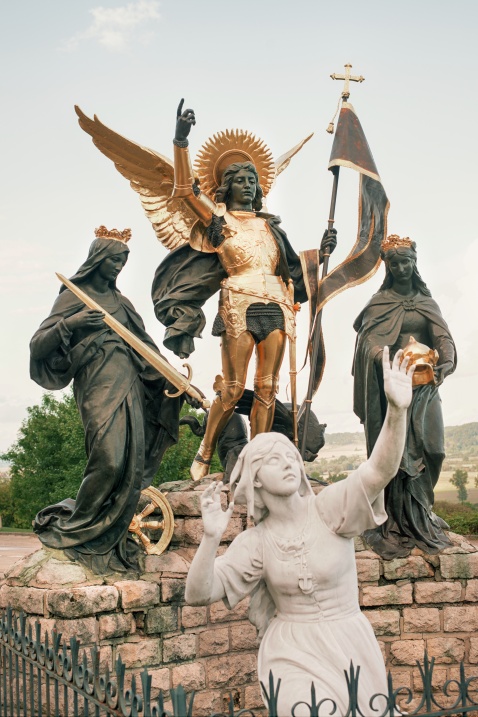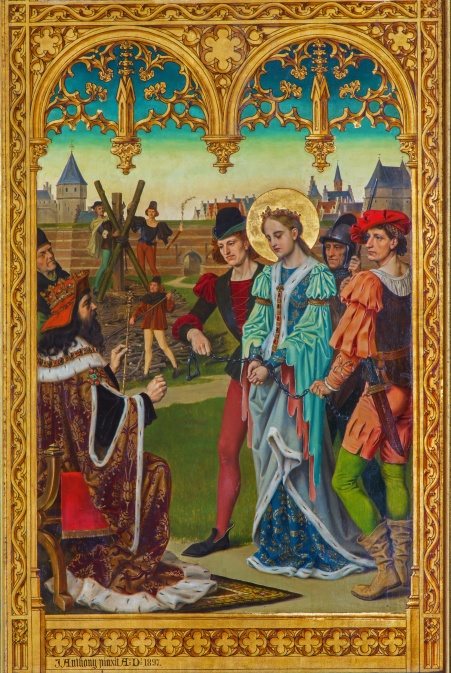
This week marks the birthday of St. Joan of Arc, a devout farm girl born more than 600 years ago whose virtues of faith, chastity, and courage helped make her one of the patron saints of France, and of soldiers in the trenches of World War One. We know her birthday—January 6—more accurately than we do the exact year of her birth, which was somewhere around 1412. (Joan testified at her trial that she believed herself to be 19 years old.) People from her village who knew her remembered her being born on Epiphany, the holiday that celebrates the moment when the Magi finally find the Christ Child they have been seeking.
Joan would have been an extraordinary person in any era, but in 15th century France, she was nothing short of mythic. Three years after she was born, Henry V achieved his decisive victory at Agincourt, and from then on England occupied France in earnest. The effect on the country was devastating, with some sources saying that this occupation reduced France’s population by as much as half. A story foretold that France would be lost by a woman and saved by a woman, or in other versions, that France would be lost by a fallen woman and saved by a virgin from the forests of Lorraine. Many of Joan’s contemporaries thought the Dauphin’s mother, reputed to have gotten her son from her husband the King’s brother, was the fallen woman who had lost France by signing away her son’s kingdom. Sometime in her teens, Joan came to believe that she was the Maid who would get it back.
Joan began hearing the voices of three particular saints when she was 13. They belonged to Michael the Archangel, Catharine of Alexandria, and Margaret of Antioch, and according to Marina Warner’s Joan of Arc: The Image of Female Heroism (UC Press 1981), they express her mission perfectly. St. Michael, leader of the armies of heaven, was the emblem of French resistance to English rule, whose image was painted on the standards of the Dauphin’s soldiers. St. Catharine confounded the scholars of the Emperor Maximus with her wisdom, spurned his marriage proposal, and was beheaded for her faith, becoming the protector of unmarried women and philosophers, as well as the patron saint of Maxey, the village nearest Joan’s own Domremy. St. Margaret, the patron saint of mothers and childbirth, also refused to marry, entered a monastery disguised in men’s clothes, and once leapt off a high building to preserve her chastity. She was later eaten by a dragon and disgorged miraculously unharmed (though she was eventually beheaded). All three saints carry swords; all three also prefigure things Joan would do before her death (though the dragon story ends differently for her, alas).

By the time Joan turned 16, she was badgering the local garrison commander for an escort to take her to the court of the disinherited Dauphin of France, the future Charles VII, whose claim to the throne had been invalidated by his mother’s treaty with the English. At the garrison and later at court, Joan’s persistence, prophetic abilities, and courage convinced everyone she met that she was sent by God. Charles believed her–reportedly because she told him the contents of a prayer he had once made in private–and granted her an army. Joan dressed as a man for the remaining years of her short life, and never married or took a lover. The soldiers who fought and slept by her side considered her a holy being, beyond earthly forms of love or sexual attraction, and claimed to lose all desire around her. They respected her devotion and insistence that they confess and hear Mass daily, and her piety helped further convince them of the justness of their holy cause.
As proof of this, and although she had no prior military experience, Joan defeated the English at Orleans and crowned Charles King. At one point she was even shot in the chest with an arrow, yet bravely fought on. Charles became more interested in treaties than battles, however, and when an impatient Joan led troops into Compiegne without his support, she was captured by the Burgundians. Like her beloved St. Margaret, Joan is said to have leapt from a tower in an attempt to escape her captors, in this case the 70-foot tower of Beaurevoir Castle, but she was recaptured. Unwilling to pay her ransom, Charles allowed her to be sold to the English, who desired her execution and thus immediately put her on trial for heresy.
The record of Joan’s trial is one of the most detailed trial records of the Middle Ages, providing a rare example of a genuine voice from the era. While most trials exist in one copy, if at all, there are dozens of copies of Joan’s (The Trial of Joan of Arc, Trans. Daniel Hobbins, Harvard UP 2005). Joan was already a celebrity by the time she was captured, and it is thought that the many copies of the transcripts were intended for widespread distribution after the trial in order to justify its unjust outcome. These efforts indicate a great deal of anxiety, stemming no doubt from certain knowledge that these proceedings were largely political rather than spiritual in nature.
As a result, we have a record in multiple copies of a brave, belligerent, and surprisingly canny voice. At one point, when asked for information about the voices of her saints, Joan blatantly refuses to answer her inquisitors: “I’ll answer you no further about that. I’ll gladly answer where I have leave to speak.” Another time, plainly impatient at being asked the same questions over and over about how she knows her voices are from God, she answers: “I’ve told you often enough that they are Saint Catherine and Saint Margaret; believe me if you wish.”
Imagine a 19 year-old young woman, captured in battle, exhausted from the hardships of prison and going days without food, standing before military and church authorities, all men, who question her relentlessly over and over, day after day. Marvel at her poised and self-contained answers. She doesn’t care what they think. She feels no urgency to defend herself, or explain her motivations. In one famous instance, she startles her Inquisitors when they demand to know whether she is in God’s grace, a trick question meant to have her fall into heresy: “If I am not, may God put me there; if I am, may God so keep me.” It was a brilliant answer, since Church doctrine held that no one could be sure of God’s grace, and Joan neatly sidesteps it, convincing many then and later that her inspiration was Divine. Its tone is sure of itself, unrattled, almost nonchalant. This is a person possessed of great faith in herself and her cause, and well as in the guiding forces that brought her to this place.
Although the Church had approved her crossdressing while she fought for Charles in battle, after her capture the English settled on Joan’s masculine dress as the crime they would use to execute her. At one point she signed a confession and was spared the stake, but in a final act of courage, she recanted, unwilling to repudiate her voices and spend her life in prison, where she feared sexual assault. Burned alive in 1431, she was celebrated publicly in France within two years of her death, and the religious plays that sprung up in her honor quickly became official sites of pilgrimage. 22 years after her martyrdom the English were expelled from most of France, and in 25, she was completely exonerated, well within what might have been her lifetime.

Joan had become a popular romantic figure by the nineteenth century, and a symbol of French nationalism by the twentieth. Her beatification in 1909, on the eve of the Great War, made her even more accessible as a personification of French courage when that war began, and by 1916, she had become a symbol of both the French and English soldiers fighting together in the trenches against Germany. In Cecil B. DeMille’s 1916 film Joan the Woman, she is a knight whose self-transcendence makes her a great warrior, a figure of both sacrifice and brave aggression. In 1920 she was canonized a saint, and 100,000 British subjects celebrated at Westminster Cathedral. In his 1924 play Saint Joan, George Bernard Shaw sees her as very like the young soldiers treated as cannon fodder by the military commanders of the Great War, a figure of forthright goodness crushed by the corrupt institutional and political machinations of old men.
In her speculative biography Saint Joan of Arc (Doubleday 1991 [1936]), Vita Sackville-West writes of Joan’s mother, “It was by no fault of Isabelle Romee, if, instead of a chicken, she had hatched an eagle.” Sackville-West seems pleased that unlike some other saints, Joan never used expressions like “my heavenly Spouse,” or “my Betrothed.” She writes: “I think that possibly she had no need thus to sublimate her earthly desires in this pseudo-sexual fashion, since she found her outlet in her ardent devotion to the Dauphin and to the cause of France. She is the least sentimental of saints, and the most practical . . .She is too heroic and bracing to appeal intimately to the average mind. She makes the mistake of being always something over life-size; something which, however much she may command admiration and respect, can never be loved in quite the same personal way as the more human saints.”
Here Sackville-West humorously inverts virtue to change our perspective on the nature of saints. Instead of beginning with Joan’s superhuman qualities, Sackville-West accuses her of missing the mark, of “making a mistake” in being too heroic and not small and human enough to love in a “personal way.” But of course, as this makes us realize, saints are not about the personal at all, but about magnificently impersonal things like justice and the greater good. Saints are little girls who strive to be more than human, who cultivate the will to defy convention, the courage to accost powerful men, and the vision to oppose crushing political orders. In the end Joan fascinates us because she decides to be something more than merely human, choosing to be burnt alive rather than spend her life in prison, or betray her faith and go against her moral principles. It may be that the job of saints is to model something greater than human frailty. It may be that the job of saints is to make us marvel at, and emulate, the courage of eagles.
Jaime Hovey is Associate Program Director for Virtue, Happiness, & the Meaning of Life.